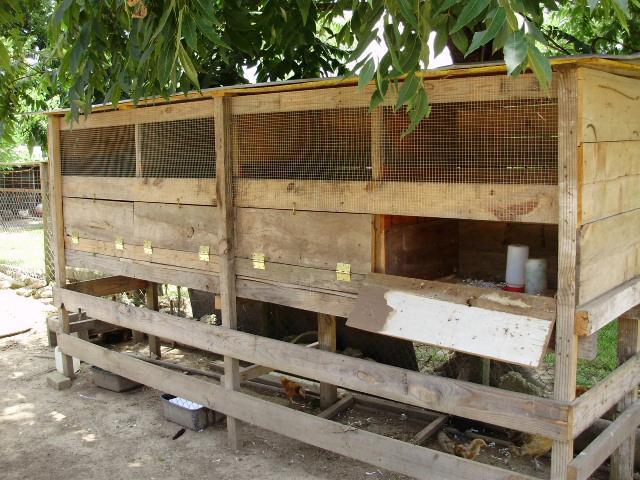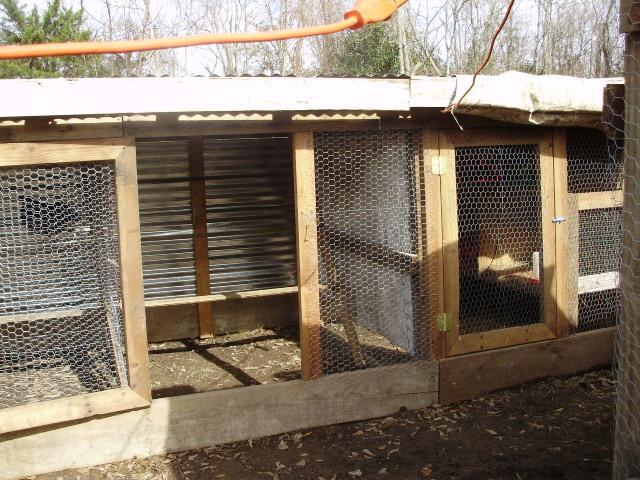deineria - This will seem a very silly question to experienced folks, but would it be wise to build a brooder box for my side porch (totally predator safe, somewhat enclosed) and move chicks into it . . .say a week after hatching?
Anyone else do this? What would you recommend doing as far as building in regards to insulation and ventilation? How many lamps in a box for - at most -24 chicks - at a time? Keeping them inside is VERY hard with little kids, a dog and limited space. . .esp more than 6-10 at a time for very long. . .
Not a silly question. I know it is "do-able" because I have experience with outside brooders and I love them! Having an outside brooder, you don't have to worry about the dust, the smell, the yucky yuck that comes with chicks being inside. This is why I have 8 outside brooders. As long as it is SAFE AND PREDATOR PROOF, I don't see a problem. In the warmer weather, my chicks are actually hatched in outside brooders and that is where they live for weeks. When I notice that my girls are going broody, I prepare the outside brooders. They usually will remain in a nesting box without getting up for 24 hours, so I know that it's time. During that 48 hour period, I move them at night. I gather some hay and I take their eggs from under them in the nesting boxes and walk to the brooders and place the eggs in the brooders on top of the hay. I also have their waterer and feeder prepared and in the brooder as well. After all eggs have been removed from the nesting box, I then go back to get the broody hen. I place a towel over her to calm her, pick her up from the nesting box and walk over to the brooder and place her on her eggs. She makes very little noise and is not at all fussy. I check on the broody before I go to work, when I get back from work and another time before I go to bed. I clean the brooder removing all poop out as often as needed and putting in fresh hay as needed. I check daily to make sure that their rear is not full of poop. I don't like them to remain setting in a clump of poop. They remain in the brooder until they hatch the babies and for weeks after that. After a couple of weeks, I allow the babies to play outside the brooder (on the ground) with their mama with my supervision. I pick each one up and place them on the ground. This gives me time to clean the brooders. After a few hours, it's back in the brooder. As they get older, I move them to another "juvenile" brooder (chicken stall - pic below). They remain their until they graduate to another area. Where you live will depend on ventilation and insulation. Sorry that I can't help you with that. In the colder months, I have the chicks (up to 20 chicks) and mom in my garage or in another outside brooder (last pic) that is built inside one of my chickens stalls. I only need 1 heat lamp and I have never lost any to freezing.
Sorry that I can't tell you about measurements because I don't build anything that I have on my property. I have someone that I tell what I want and how I want it and he builds it exactly to my specifications.

Here is a pic of one of my outside brooders. This is predator proof. Have not had 1 single problem with any predators geting in this brooder. I guess the predator would have to be 5 foot tall because this is a raised brooder.
This is a pic of the brooder that was in use at the time of the pic. I let the babies and mother out on this day. You can see them at the botton on the ground piddling around.

This is a not so good pic of my broody hens. At the time of this pic, I was cleaning out their brooders, waterers and feeders. This is what it looks like when it's full of broody hens.

This is a pic of the mama and her babies inside of the outside brooder that is in a chicken stall. Pic below.

Outside brooder built inside chicken stall. Where the door is closed is the entrance to the brooders. This brooder is used in cooler/colder weather. Heat lamps are placed in the brooder and tarps are used to cover the door, sides, etc. To the left of the baby brooder is the juvenile brooder with roosts. As the chicks get older they graduate to this type of stall. If the temps are too low while in this stall, a heat lamp is placed inside for warmth.

I hope that some of this helps. Sorry that I was so detailed. I write like I talk. TOO MUCH !!!

Anyone else do this? What would you recommend doing as far as building in regards to insulation and ventilation? How many lamps in a box for - at most -24 chicks - at a time? Keeping them inside is VERY hard with little kids, a dog and limited space. . .esp more than 6-10 at a time for very long. . .
Not a silly question. I know it is "do-able" because I have experience with outside brooders and I love them! Having an outside brooder, you don't have to worry about the dust, the smell, the yucky yuck that comes with chicks being inside. This is why I have 8 outside brooders. As long as it is SAFE AND PREDATOR PROOF, I don't see a problem. In the warmer weather, my chicks are actually hatched in outside brooders and that is where they live for weeks. When I notice that my girls are going broody, I prepare the outside brooders. They usually will remain in a nesting box without getting up for 24 hours, so I know that it's time. During that 48 hour period, I move them at night. I gather some hay and I take their eggs from under them in the nesting boxes and walk to the brooders and place the eggs in the brooders on top of the hay. I also have their waterer and feeder prepared and in the brooder as well. After all eggs have been removed from the nesting box, I then go back to get the broody hen. I place a towel over her to calm her, pick her up from the nesting box and walk over to the brooder and place her on her eggs. She makes very little noise and is not at all fussy. I check on the broody before I go to work, when I get back from work and another time before I go to bed. I clean the brooder removing all poop out as often as needed and putting in fresh hay as needed. I check daily to make sure that their rear is not full of poop. I don't like them to remain setting in a clump of poop. They remain in the brooder until they hatch the babies and for weeks after that. After a couple of weeks, I allow the babies to play outside the brooder (on the ground) with their mama with my supervision. I pick each one up and place them on the ground. This gives me time to clean the brooders. After a few hours, it's back in the brooder. As they get older, I move them to another "juvenile" brooder (chicken stall - pic below). They remain their until they graduate to another area. Where you live will depend on ventilation and insulation. Sorry that I can't help you with that. In the colder months, I have the chicks (up to 20 chicks) and mom in my garage or in another outside brooder (last pic) that is built inside one of my chickens stalls. I only need 1 heat lamp and I have never lost any to freezing.
Sorry that I can't tell you about measurements because I don't build anything that I have on my property. I have someone that I tell what I want and how I want it and he builds it exactly to my specifications.

Here is a pic of one of my outside brooders. This is predator proof. Have not had 1 single problem with any predators geting in this brooder. I guess the predator would have to be 5 foot tall because this is a raised brooder.
This is a pic of the brooder that was in use at the time of the pic. I let the babies and mother out on this day. You can see them at the botton on the ground piddling around.

This is a not so good pic of my broody hens. At the time of this pic, I was cleaning out their brooders, waterers and feeders. This is what it looks like when it's full of broody hens.

This is a pic of the mama and her babies inside of the outside brooder that is in a chicken stall. Pic below.

Outside brooder built inside chicken stall. Where the door is closed is the entrance to the brooders. This brooder is used in cooler/colder weather. Heat lamps are placed in the brooder and tarps are used to cover the door, sides, etc. To the left of the baby brooder is the juvenile brooder with roosts. As the chicks get older they graduate to this type of stall. If the temps are too low while in this stall, a heat lamp is placed inside for warmth.

I hope that some of this helps. Sorry that I was so detailed. I write like I talk. TOO MUCH !!!


